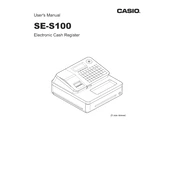Casio SES100 User's Manual


To change the receipt paper, open the printer cover, remove the old paper roll, and insert a new roll with the paper feeding from the bottom. Ensure it feeds correctly through the printer before closing the cover.
To program the tax rate, turn the key to the 'PGM' position, select 'Tax', and then enter the desired tax rate. Confirm by pressing the 'CA/AMT' button.
First, ensure there is no obstruction. If the problem persists, turn the key to the 'OFF' position and gently wiggle the drawer. If necessary, consult the user manual for further instructions.
To reset the register, turn the key to the 'PGM' position, then press and hold the 'CLR' button while turning the key to the 'OFF' position. Release the 'CLR' button and restart the register.
To perform a daily sales report, turn the key to the 'Z' position and press the 'CASH' button. The register will print the report showing daily sales data.
Check the user manual for the specific error code. Common solutions include resetting the register or ensuring all connections are secure. If the error persists, contact customer support.
To change the date and time, turn the key to the 'PGM' position, select 'Date/Time', enter the correct date and time using the numeric keys, and then confirm by pressing 'CA/AMT'.
Use a soft, dry cloth to clean the exterior. Avoid using liquids or abrasive materials. For internal components, refer to the user manual for detailed cleaning instructions.
The Casio SES100 does not have native support for computer connectivity. Data management needs to be done manually via printed reports and manual data entry.
Check that the power cord is securely connected and that the outlet is functioning. If the problem persists, check the fuse and replace it if necessary. Consult the manual for further troubleshooting steps.